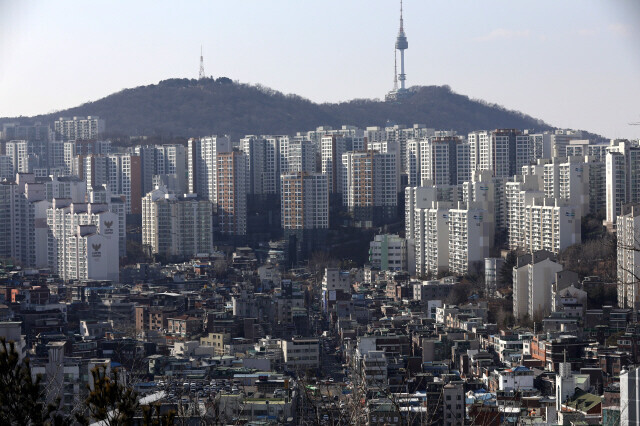hankyoreh
Links to other country sites 다른 나라 사이트 링크
Average worker needs to save 8 years worth of income to buy home in greater Seoul area, study shows

The percentage of all South Korean households that failed to meet minimum residential standards fell to an all-time low last year, a study shows.
But the rent-to-income ratio (RIR) for renters rose from its 2019 level, showing that the burden of residential costs is growing for ordinary South Koreans who do not own homes.
These were among the findings announced Friday by the Ministry of Land, Infrastructure and Transport from its survey of South Korean housing conditions for the year 2020. The ministry commissioned the Korea Research Institute for Human Settlements (KRIHS) to study a sample of 52,000 households nationwide between July and December of last year.
According to the findings, the percentage of households failing to meet minimum residential standards fell by 0.7 percentage points from 5.3% in 2019 to 4.6% in 2020. The rate was as high as 5.9% in 2017 — the year the Moon Jae-in administration took office — but showed a decline for three straight years beginning in 2018.
Per capita residence area also increased from 32.9 square meters in 2019 to 33.9 square meters last year.
But in terms of the actual residential costs for renters, the burden has only grown.
In 2020, the RIR for renters nationwide, or the amount of rent paid as a percentage of monthly income, totaled 16.9%. The ratio was up slightly from 16.1% in 2019. South Korea’s RIR reached an all-time low of 15.5% in 2018, but rose for both years afterward, hitting 16.1% in 2019 and 16.6% in 2020.
The median price-to-income ratio (PIR), or the cost of buying a home as a percentage of the homeowner’s annual income, stood at 5.5 nationwide last year, up slightly from 5.4 the year before.
For the greater Seoul area, the PIR totaled 8.0, up from 6.8 in 2019. This means that the amount of time it would take for a greater Seoul resident to save enough monthly salary to purchase a home — if they did not spend it on anything else — increased from 6.8 to 8 years.
Over the same period, the PIR for metropolitan cities outside the greater Seoul area rose from 5.5 to 6.0, while the one for provinces outside of the capital region rose from 3.6 to 3.9.
The number of years taken to acquire a first home was also up to 7.7 last year, compared with 6.9 the year before. The incident was at its largest since 2016.
The owner-occupancy ratio, indicating the percentage of households living in a home they own, was 57.9% for last year, down slightly from 58.0% the year before. The ratios fell slightly for the greater Seoul area (50.0% to 49.8%) and other metropolitan cities (60.4% to 60.1%), but rose for provinces outside of the capital region (68.8% to 69.2%).
The home ownership ratio, or the percentage of households owning a home, totaled 60.6% nationwide, down from 61.2% in 2019. Over the same period, it rose from 71.2% to 71.4% for provinces outside the capital region, but slipped from 54.1% to 53.0% for the greater Seoul area and from 62.8% to 62.2% for other metropolitan cities.
According to the KRIHS, the reason for the lower owner-occupancy and home ownership ratios has to do with an increase in “household differentiation.” In other words, while the supply of housing has been increasing steadily, the ratios have declined amid differentiation trends including an increase in single-person households.
By Choi Jong-hoon, staff reporter
Please direct comments or questions to [english@hani.co.kr]

Editorial・opinion
![[Column] When ‘fairness’ means hate and violence [Column] When ‘fairness’ means hate and violence](https://flexible.img.hani.co.kr/flexible/normal/500/300/imgdb/original/2024/0516/7417158465908824.jpg) [Column] When ‘fairness’ means hate and violence
[Column] When ‘fairness’ means hate and violence![[Editorial] Yoon must stop abusing authority to shield himself from investigation [Editorial] Yoon must stop abusing authority to shield himself from investigation](https://flexible.img.hani.co.kr/flexible/normal/500/300/imgdb/original/2024/0516/4417158464854198.jpg) [Editorial] Yoon must stop abusing authority to shield himself from investigation
[Editorial] Yoon must stop abusing authority to shield himself from investigation- [Column] US troop withdrawal from Korea could be the Acheson Line all over
- [Column] How to win back readers who’ve turned to YouTube for news
- [Column] Welcome to the president’s pity party
- [Editorial] Korea must respond firmly to Japan’s attempt to usurp Line
- [Editorial] Transfers of prosecutors investigating Korea’s first lady send chilling message
- [Column] Will Seoul’s ties with Moscow really recover on their own?
- [Column] Samsung’s ‘lost decade’ and Lee Jae-yong’s mismatched chopsticks
- [Correspondent’s column] The real reason the US is worried about Chinese ‘overcapacity’
Most viewed articles
- 1China calls US tariffs ‘madness,’ warns of full-on trade conflict
- 2[Column] When ‘fairness’ means hate and violence
- 3[Column] US troop withdrawal from Korea could be the Acheson Line all over
- 4Could Korea’s Naver lose control of Line to Japan?
- 5[Editorial] Yoon must stop abusing authority to shield himself from investigation
- 6[Column] How to win back readers who’ve turned to YouTube for news
- 7DongA Ilbo and the government are told to apologize for past civil rights violations
- 8S. Korea’s spy agency ramping up national security investigations to keep itself relevant, critics s
- 9A Korean production studio may have made your favorite show – even if you don’t watch K-dramas
- 10[Column] Samsung’s ‘lost decade’ and Lee Jae-yong’s mismatched chopsticks